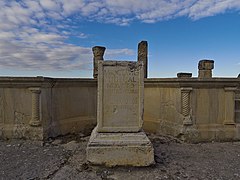Roman prefect
The prefect (from the Latin praefectus and praeficere, that is, to be in front of) was an authority of the Roman Empire and the Republic roman. Its attributions covered both the military and the civil sphere. The position had a variable rank and was normally held by a person from the equestrian order. In the civil field, the prefect was not a magistrate, but a substitute for it.
Grammatically, at first the term praefectus appears qualified with expressions either in the dative case (thus praefectus praetorio) or in the genitive case. Later, the genitive will prevail.
The prefect of Rome or prefect of the city (from the Latin praefectus urbis) in Ancient Rome assumed the functions of the king in his absence. Later he did the same with the consular functions, until such a mission passed to the praetors.
The creation of the Pretura determined the loss of importance of this magistracy, which only preserved the organization of the Latin festivities.
During the Roman Republic:
- the praefectus: Army officer with various tasks, usually extraordinary;
- the praefectus civitatis: Officer assigned to the government of a city;
- the praefectus fabrum: At first he was a chief military engineering officer with full powers;
- the praefectus orae maritimae: it was up to him to monitor the control of the coast;
- the praefectus socium (sociorum): Roman officer in command of a wing sociii.e. italics or other peoples;
- the praefectus urbi: that made the guard of the city during the annual sacrifice of the faire latinae in Mount Albano, where the consuls also participated. His previous title was custos urbi (guardian of the city);
During the Roman Empire:
- the praefectus praetorio (prefect of the pretorian): he commanded the bodyguards of the emperor, that is, the pretorian guard; with the reform of the institutions carried out by Diocletian in the year 300, the prefects of the pretoria became administrators of the prefectures;
- the praefectus urbi: it is known since the regio period, it was an extraordinary magistrate of the Senate rank, it was the judge that the consul appointed to replace him in the head of the city of Rome and in the exercise of his jurisdictional functions while he was absent;
- the praefectus Alexandriae et Aegypti: governor of the province of Egypt;
- the praefectus Mesopotamiae: governor of the province of Mesopotamia from Septimio Severo;
- the praefectus vigilum: commander of the Watches (nighters);
- the praefectus annonae: responsible annona (food and cereal rationing and use policy);
- the praefectus Iudaeae: Officer with authority over the Judea district;
- the praefectus gentis or civitatum: officer who had authority over some unRomanized peoples;
- the praefectus Caesaris: substitute of the emperor (or of another personality, in the municipal positions);
- the praefectus vehiculorum: responsible cursus publicus (Transit);
- the praefectus castrorum: commander of a military camp;
- the praefectus alae: commander of a cavalry wing;
- the praefectus cohortis: commander of a cohort;
- the praefectus classis: commander of a fleet;
- the praefectus equitum: commander of the cavalry;
- the praefectus fabrum: Chief officer of military engineers only during the High Empire;
- the praefectus orae maritimae: Prefect with coastal control tasks;
- the praefectus legionis: commander of equestrian rank, of a legion;
- the praefectus legionis agens vice legati: commander of a legion that has the delegation of a legacy;
- the praefectus ripae Danubii and other rivers: responsible for the banks and waters of the Danube.
Contenido relacionado
Swastika
Latvian history
Philippine-American War

